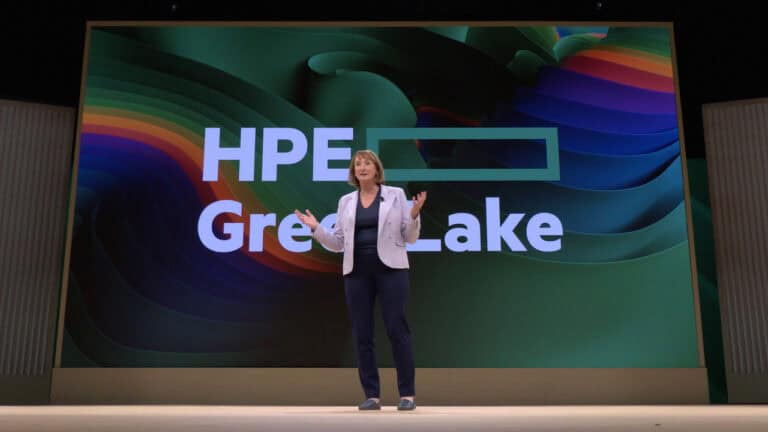Organizations that want to innovate quickly are choosing a scalable cloud strategy. This can be achieved in both the public and private cloud. HPE GreenLake is the fastest-growing on-premises stack that allows organizations to do virtually anything. As Fidelma Russo, HPE’s CTO, sums it up; “HPE builds and acquires what customers need within their stack.”
Years ago, HPE was a company that already offered a fully integrated stack. HPE had the hardware, HPE UX and various other solutions on top of that stack. Then, the market shifted to a best-of-breed strategy. Now, organizations are adopting cloud strategies and choosing vendors offering a complete stack or solution, including the necessary guarantees.
Organizations with a cloud strategy can choose between hyperscalers such as AWS, Microsoft or Google, or for a private cloud in their own data center. Of the major traditional hardware vendors (such as HPE, Dell and Lenovo), HPE is leading the way in private cloud offerings with GreenLake.
Everything is software-defined
While hardware is still the foundation of any stack, HPE GreenLake makes a difference with the combination of hardware, software and AI on-premises. HPE used to differentiate itself with unique hardware, such as proprietary chips for faster storage, but today, everything is software-defined. This has enabled HPE to offer its storage solutions to hyperscalers as well. This allows organizations to implement storage solutions from HPE that run both on-premises and in the cloud, with centralized management.
HPE GreenLake began with compute, storage and networking, but now offers much more, including data management, observability, analytics for sustainability and energy efficiency. Fidelma Russo says she is in weekly discussions with customers about their experiences, how the solutions work together and, most importantly, what is still missing. Based on this, HPE’s strategy is determined and which new developments are needed. These new solutions can be developed by HPE or by making acquisitions.
HPE plays chess on a global level
Developing or acquiring all the new technologies that come onto the market is too ambitious even for HPE. Every day new technologies appear that can be interesting, but you can’t develop or buy everything. You need to pick and choose the right solutions, for the rest HPE works with crucial partners such as Red Hat, Nutanix, VMware, Cohesity, Commvault and many others.
That sometimes means that HPE offers solutions that compete with those same partners. This creates challenges, and then it becomes a strategic chess game for HPE. Recently, HPE attracted a lot of attention with the introduction of HPE VME, a virtualization solution to replace VMware vSphere at organizations. The development of HPE VME stemmed from customer demand for an affordable alternative to VMware. This turned out to be a very strategic move, HPE was surprised by the high demand and enthusiasm for the product.
HPE VME: a strategic move
What started as an idea to add virtualization to existing HPE solutions has grown into a full-fledged enterprise software solution. HPE VME can not only compete with VMware, but also be used on competitors’ hardware stacks. Realizing that not every data center consists entirely of HPE hardware, HPE has made sure that HPE VME can run on any x86 server.
A few years ago, it would have been unthinkable for a company to challenge VMware in the virtualization market. Nutanix has been trying for years, but VMware has always remained the dominant player. However, Broadcom’s acquisition of VMware and subsequent changes have turned everything upside down. The high prices, especially, caused dissatisfaction among organizations. HPE’s investment in virtualization and acquiring Morpheus Data has been a grandmaster move, one that may even checkmate Broadcom in the long run.
Fidelma Russo sums it up, “Sometimes you just get lucky.” In terms of timing, the acquisition of Morpheus Data came at the perfect time. However, the acquisition was planned for much longer. She emphasizes that the development of HPE VME is far from complete. Improvements in management, observability, storage and networking are being seriously considered.
HPE Greenlake is a full cloud offering on-premises
HPE has built a portfolio with HPE Greenlake that allows it to deliver more or less a full cloud offering in on-premises. At the same time, it can also scale many services to the public cloud. HPE Greenlake’s portfolio is extensive, whether it’s computing, storage, observability, AI, or virtualization. As an organization, a lot is taken off your hands; for example, you don’t have to estimate your needs. HPE manages the entire lifecycle, including how much hardware you need, also taking care of patches and updates on all hardware.
HPE ensures that the hardware and solutions function flawlessly and performs preventive maintenance to avoid downtime. To do this, HPE has developed HPE InfoSight, an AI-driven solution that monitors all HPE Greenlake hardware worldwide and can analyze very closely when a machine is not behaving as it should. HPE is very progressive in the data center equipment and solutions market with GreenLake. Based on our research, the competition has not yet found an appropriate answer to this.
